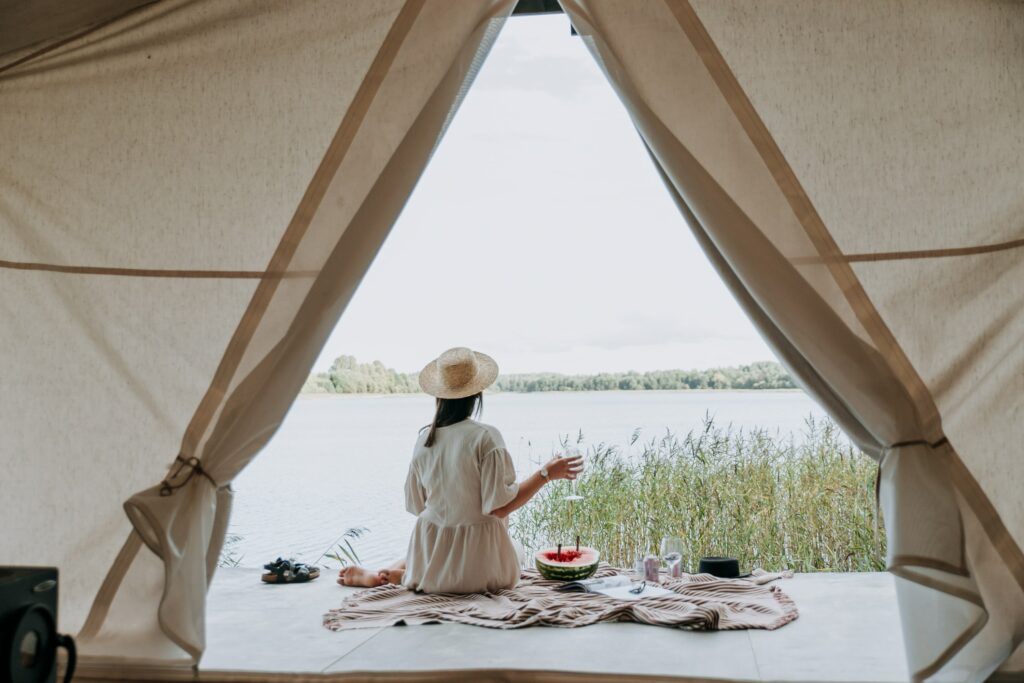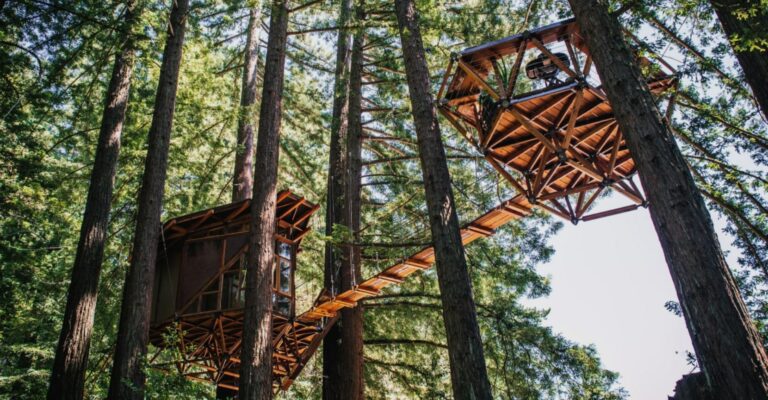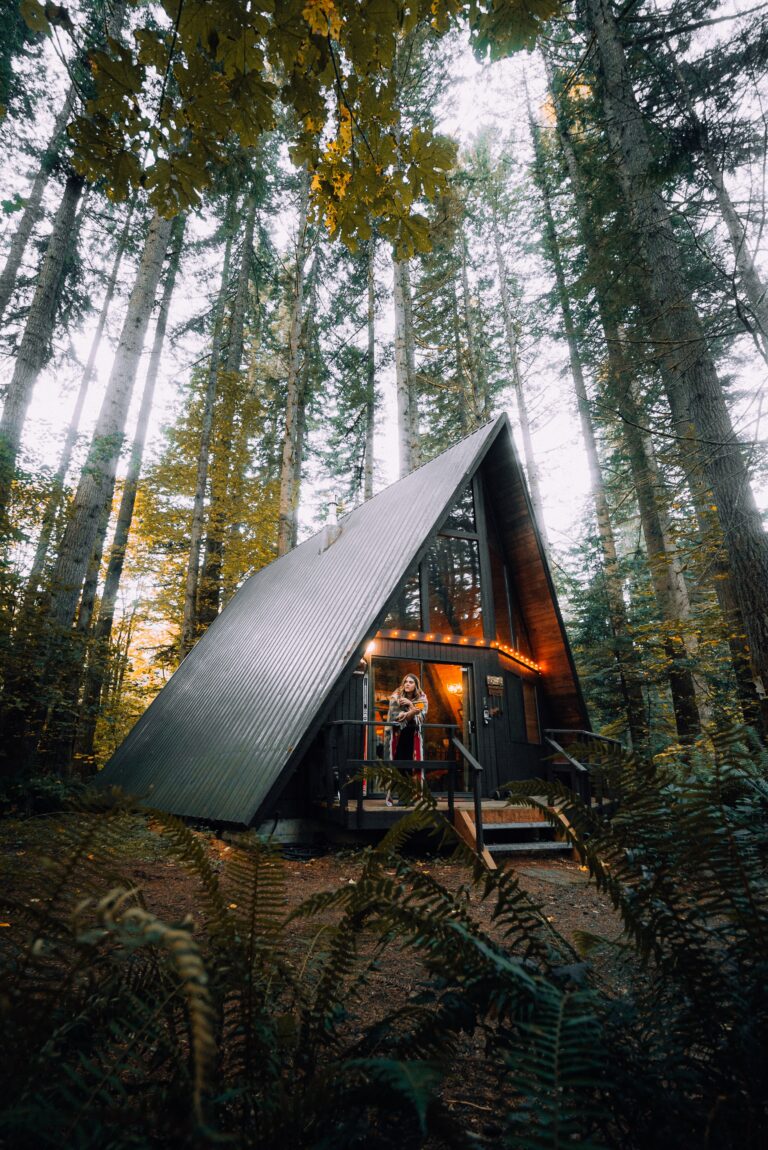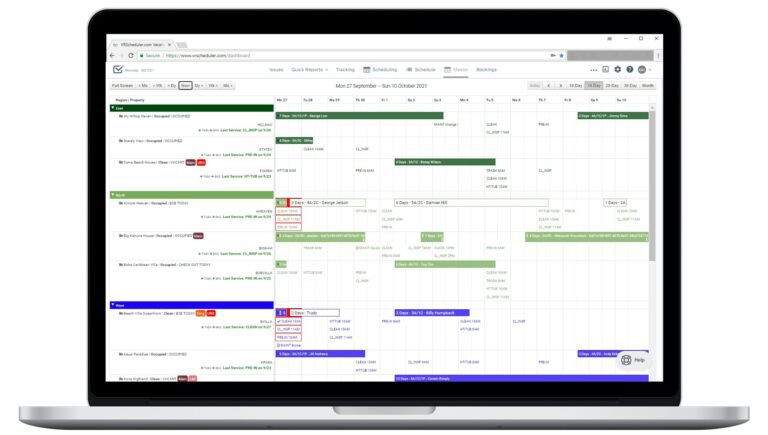Writing Your Glamping Business Plan in 2025

Vacation rental operators all around the world are talking about glamping:
What kinds of experiences it facilitates, how much guests love it, how much money it’s generating worldwide, and what a low initial investment it requires when compared with fixed property.
It’s true—glamping started as a hot trend and has since carved out what looks like a permanent place in the global hospitality industry. Even better, the market’s growth and future projections show that it’s nowhere near saturated.
There’s still lots of room for savvy entrepreneurs to set up glamping sites, create unforgettable experiences for people all around the world, and enjoy steady streams of revenue.
If you’re one of those savvy entrepreneurs, you’ll need a plan to get started. But we all know how time-consuming and even limiting creating hospitality business plans from scratch can be.
Luckily, we’ve created a detailed glamping business plan template and included it in this article just for you. Use it to outline all the aspects of your own glamping business idea and you’ll have a great tool that’ll instill confidence in investors and help you secure the initial funding you’ll need to start.
Let’s begin.
Is now a good time to enter the glamping industry?
There’s no time like the present to venture into the glamping industry. The variety of successful glamping projects popping up around the world demonstrates that it’s morphing from a niche into a well-established hospitality business model.
For example, glamping giant Treewalkers has gone from renting out a single treehouse structure to starting a treehouse franchise with over 85 sites worldwide over the past 17 years.
Ultimately, the potential of the glamping industry hasn’t even begun to be tapped. People increasingly need an escape from their hectic city lifestyles, but they also need the comforts of home so they can unwind and relax without any stress.

It’s safe to say that glamping is here to stay, and there are plenty of business opportunities ripe for the picking.
Current state of the glamping industry
The global glamping market is undoubtedly positioned for growth. As of 2021, it’s valued at $2,348.7 million and is expected to increase with a compound annual growth rate (CAGR) of 10.9%.
The glamping market’s projected growth is attributed to the following trends:
- The ever-growing popularity of tourism
- More disposable income and willingness to spend it on unique experiences
- The rise of ethical consumerism
- Rising consumer awareness of glamping
- Growing popularity of staycations
The North American glamping market
Behind Europe, North America has one of the biggest worldwide markets for glamping due to the popularity of outdoor activities and vacations.
In fact, glamping in North America is projected to have the fastest CAGR between now and 2030. It’s particularly popular with people between 18-32 and 33-50.
Is glamping a profitable business?
Glamping businesses can be very profitable due to their low startup costs when compared with fixed property vacation rentals. Of course, you’ll need to secure a bit of money to get started, but your return on investment (ROI) should be quick once you get your sites up and running.
One of the make-or-break factors of starting a profitable glamping business is being realistic about up-front costs. When putting together your budget, make sure you investigate all potential expenses, leave yourself some breathing room, and account for unexpected factors like price increases or material delays. That’ll make sure you don’t end up needing more money than you budgeted for.
To illustrate just how profitable unique vacation rentals can be, consider this example. Imagine you’ve explored how to set up a glamping business and want to build and rent out some yurts in a beautiful forest. Let’s estimate that each yurt costs $10,000 to set up and furnish, and you begin by kitting out five. That’s a $50,000 investment.
Yurts can bring in anywhere from $6,000 to $8,000 per month once they’re up and running, depending on factors like amenities, size, occupancy rates, and time of year. That means you could conservatively make $30,000 gross from your yurts in a month if everything went well.
That’s great news for investors because they could start making a profit on their investment after just a few months.
In addition, glamping sites and unique vacation rentals lend themselves to all kinds of additional revenue possibilities, including:
- Offering rentals like bicycles & beach equipment
- Selling merch & supplies like firewood
- Partnering with local businesses for tours, activities, and excursions
- Providing on-site meals
What to include in your glamping business plan
There’s lots of information you can include in your glamping business plan, but focus on what would be most important to partners, investors, and stakeholders. After all, you’re likely creating this business plan because you want to capture people’s interest and secure funding.
Here are some must-include glamping business plan elements:
Executive summary
Business plans are usually long documents, so include an executive summary at the beginning that’s easy for stakeholders to skim through. They should be able to get a feel for your glamping business idea at a glance.
Your executive summary should be comprehensive, concise, and persuasive because it’ll be key for securing partners and funding.
Here’s the main information you should include:
- An introduction to your business where you explain what inventory you currently have and your experience in the glamping or hospitality industry. If you have a proven track record of starting successful vacation rental businesses, even if they aren’t glamping related, it’ll make your case much stronger for investors.
- An explanation of your motivations and objectives for venturing into the glamping industry.
- A description of your target market and the problems you’ve going to solve for them with your business idea.
- A quick summary of the market research you’ve done and the conclusions you’ve drawn from it, including market size.
Conduct market and revenue potential research
Doing your own research on the glamping market where you’ll be doing business will instill confidence when you’re looking for partners and funding. You’ll show you understand what you’re getting into, have done your homework, and are familiar with existing opportunities and challenges.
Some specific research to include here includes:
- The value of the glamping and unique vacation rental market you want to enter
- Relevant local glamping and unique vacation rental trends
- How much revenue different kinds of glamping sites bring in your area
- How saturated your glamping market is and why that is or isn’t the case
- Local weather and seasonality and what they would mean for your glamping business
To conduct this kind of research:
- Take it to Google and market intelligence platforms like AirDNA, Transparent, and Mashvisor. Explore what kinds of relevant hospitality industry studies and reports you can find.
- Search popular online travel agencies (OTAs) to get a feel for what properties are popular and what their rates look like.
- Talk with local professionals working in the glamping industry. If you don’t know any, try using professional networking sites like LinkedIn and Nokori Pulse to connect with some.
- Conduct interviews with people who have glamped or would be interested in glamping to get to know their likes, dislikes, and pain points.
Undertake competitive analysis
Now that you’re familiar with your glamping market, it’s time to take a look at your competitors.
First, find glamping and unique vacation rentals that have similar concepts to your business idea. They don’t have to be exactly the same, but their amenities, location, size, and features should be similar.
Use search engines or vacation rental software like Airbnb, Booking.com, VRBO, and Glamping Hub to find your competitors. It’s a good idea to search across different platforms, as well as to check more country or region-specific sites not listed here.
Then, dive into the following questions:
- How many glamping and unique vacation rentals are my competitors?
- What are my competitors’ strengths and weaknesses?
- How successful are my competitors? Are they fully booked all year round, or only seasonally? What’s their pricing scheme? How are their reviews?
- What are my competitors’ marketing strategies? What are they doing to promote their properties and what platforms are they using?
- Who are my competitors’ ideal customers? Are they all similar or do they vary from property to property?
- What could I do to make my glamping site stand out from these competitors?
Define your offering
Here, you should explain what kind of glamping business you want to start.
The definition of glamping has expanded beyond just a glamorous camping experience. It’s now broader and includes various unique experiences where guests stay in the great outdoors (rather than in a fixed property) with all the comforts of home.
Three glamping styles that currently take up a significant portion of the market are:
- Treehouses
- Eco-pods
- Tiny homes and cabins
However, the sky’s the limit when it comes to glamping business models. Some additional examples include:
- Canvas tents and A-Frame tents
- Yurts, huts, and domes
- Reformed barns and refuges
- Campervans, airstreams, and RVs
- Boats and floating homes
- Igloos
To make a persuasive case to potential investors and stakeholders, be sure to identify what your glamping site has to offer that your competitors don’t. Be explicit about your business’s unique sales proposition (USP) and describe what market gaps your properties will fill.

For instance, imagine you’re building tiny cabins to rent out as a unique vacation rental business. Your geographic area already has lots of tiny cabins, so describe what makes yours special:
- My tiny cabins come equipped with special private amenities like saunas and/or jacuzzis
- My tiny cabins are the only ones in the area that are lakefront and have private access to the shoreline
- My tiny cabins use smart locks to provide extra protection and security
- My tiny cabins have access to private fire pits
Explore marketing opportunities
Once you’ve decided what kind of glamping business you want to start, determine how you’ll get the word out about your properties once you’re ready for bookings.
Consider the marketing tactics outlined below and decide which would be suited to your unique vacation rental business:
- Make a listing on a vacation rental platform: When you begin your glamping business, you’ll almost certainly need to publish your property on a site like Airbnb or Glamping Hub to get your first external bookings. Be sure to choose the platforms that are most popular in your area and put time and effort into your listings. Include good quality photos, write a detailed description, provide accurate details about your amenities, and tell potential guests what other activities are nearby. It’s also important to make your listing name unique, attention-grabbing, and searchable.
- Create your own website: When your glamping business gets more well-established and you have a steady stream of bookings coming in, you may choose to move your listings onto your own website and promote it with paid ads and through social media. Building your own glamping website helps solidify your brand and cuts out the middleman when it comes to reservations.
If you’ve already got a hospitality business going and are venturing into glamping for the first time, you might already have a website. If that’s your case, you can integrate your new glamping properties into your existing website and cross-promote it there.
- Lean on your community: Your first bookings will likely come from people you know. Take advantage of that momentum and continue to spread the word about your glamping business within your community. Connect with local businesses to promote your new undertaking and ask your friends and family to tell everyone they know about it. Offer special referral or community discounts to sweeten the deal.
- Email marketing: When your glamping business becomes a great success, you’ll have lots of guests that are so happy with their experience that they want to keep booking with you in the future. You might also get people browsing your website before they’re ready to choose a date and reserve. Creating an opt-in form on your glamping business website is a great way to build your email marketing subscriber list, making it easy to keep in touch with your potential and existing guests.
- Social media marketing: Glamping businesses sell more than just lodging. They sell experiences. Captivate potential guests and internet browsers with all your properties have to offer by putting your best face forward with a carefully organized social media marketing plan. Platforms like Facebook, Instagram, and even TikTok are particularly popular in the glamping industry.
Remember, having a steady stream of high-quality and audiovisual content is imperative if you want to promote your business on social media. You can ask your guests to share their photos and videos, but you’ll likely need someone on staff to take care of content creation as well.
Outline your budget and financial plan
This is one of the most vital aspects of your glamping business plan because investors will want to understand the following:
- How much money your glamping business will require at the outset
- How quickly they’ll see any ROI
- How much revenue potential your glamping business will continue to have in the future
To establish an accurate budget for your glamping business, break down all the costs associated with setting up. Include everything from structure materials to labor to furniture to linens.
Then, determine all the regular expenses your glamping business will have to pay once things are up and running. This includes:
- Cleaning, laundry, maintenance & repair services
- Staff & other operational expenses
- Insurance, permit & licensing costs
- Software & computer systems
It’s also important to make a case for your software of choice. For example, Operto Teams has a huge impact on operational efficiency and removes the need for other software in your tech stack. That means the value it brings to your business far outweighs the cost of the tool itself.
Once you’ve painted a thorough picture of how much your glamping business will cost, you can move on to the fun stuff. Show stakeholders:
- How you’ll track the success of your glamping business with metrics like expected occupancy and revenue per available room
- When you predict your glamping business will break even and become profitable
- Revenue projections for different time periods (for example, a year and five years into the future)
Define your business structure and operations
Coming up with a glamping idea is great, but investors will want to know how you’re planning to run your business on a day-to-day basis.
Get specific about the operational side of your unique vacation rental by providing the following information:
- Your team: If you’ve just started your glamping business, your team will be relatively small. However, it’s still important to identify who will be in charge and who will be hired to get things done. It’s equally vital to contract people who know what they’re doing and will help you grow your business. Explain whether you’re planning to run your glamping site yourself or whether you’ll hire a manager. Also account for other key employees like cleaning staff, maintenance staff, security personnel, assistants, and photographers.
- Communications and scheduling: It’s also a good idea to account for what staff schedules will look like and how employees will communicate with each other in your business plan. It’ll reassure stakeholders that you have a strong, efficient vision for how your business will be run. It’ll also save you headaches down the road as you’re deciding nitty-gritty operational details before you start scaling your business. Software like Operto Teams provides employees with personal dashboards and automatically populates their calendars with tasks based on bookings, which saves you hours of time and manual work.
- Your guest experience: Many glamping business owners use software to streamline and simplify their daily operations. Be explicit about what kind of software you’ll use (if any) and whether it’s internal, external, or both. Tools like Operto Guest are great for unique vacation rentals because they provide guests with all the essential information they need in one handy app, like local guides, details on the type of accommodation, property instructions, host messaging, and in-app upselling.
- Safety & security: Safety can be a serious hurdle for glamping business owners. Glamping sites are often isolated, so it’s harder for guests and employees to access emergency services or police should things go awry. Outline the safety procedures that should be followed if necessary as well as the security measures that you have in place. For example, identify whether you’ve set up secure keyless access for guests, remote occupancy monitoring, or will personally be responsible for comings and goings.

Make your request for funding
There’s no one way to secure funding for a unique vacation rental, but here are some options:
- Crowdfunding: Make a fundraiser on a platform like GoFundMe and get your community to help you raise money to set up your first glamping site.
- Startup investments: Platforms like StartEngine help startups and early-stage companies find investors by offering investment opportunities.
- External investors: If your glamping business is a good investment opportunity and you make a good case for it, you’ll likely be able to get external real estate investors interested in coming on board.
- Bank loans & lines of credit: Apply for a bank loan or line of credit to get the money you need to build and launch your first few glamping properties.
- Partnerships: Consider whether there’s anyone in your personal or professional network who’d want to go into business with you. They’d agree to invest a certain amount and get a percentage of your profits down the line.
Glamping business plan template
We’ve condensed all the above information down into a simple and effective glamping business plan template. Copy it and customize it according to your business needs and you’ll have a great resource that’ll help you get your business off the ground.
MY GLAMPING BUSINESS PLAN
Date:
Location:
Glamping business name:
Contact person name:
Contact person phone number:
Contact person email:
Names of other existing partners and stakeholders:
Executive Summary:
Provide a summary of your glamping business idea that someone could skim through and understand in just a few minutes.
Include the following key points:
- Introduction to your business and your experience in the industry
- Motivations and objectives for venturing into the glamping industry
- Description of your target market and the problems you’ll solve for them
- Quick summary of market research
Market and Revenue Potential Research:
Tell stakeholders what kind of market you’re getting into and how much money there is to be made.
Competitive Analysis:
Identify your competitors, determine their strengths and weaknesses, analyze their success, take note of their marketing strategies, and consider their ideal customers. Then, use that information to explain how your glamping business will be even better than theirs.
Glamping Type and Unique Selling Proposition (USP):
Be specific about what kind of glamping or unique vacation rental business you want to start and what market holes it will fill.
Marketing Strategy:
Explain how you’re going to get the word out about your glamping business and what marketing strategies you’ll use to promote it in the future.
Budget and Financial Plan:
Break down how much your glamping business will cost, both to initially set up and operate on an ongoing basis. Then, be specific about when investors will see returns and include future revenue projections.
Business Structure & Operations:
Describe how your glamping business will be run on a day-to-day basis. Include details about your team, communications, scheduling, guest experience, and security measures.
(Optional) Funding Request:
If you’re sharing your glamping business plan in hopes of securing funding, investments, or partners, including information specific to your request at the end.
For example, if you want investors to put in a certain amount and have projections for when they could 3x that money back, conclude with that. Images are also worth a thousand words, so graphics and visuals are great to add as well.
Repeat glamping business name:
Repeat contact person name:
Repeat contact person phone number:
Repeat contact person email:
Creating an effective plan for your glamping business
If you want to venture into the glamping industry, the first step you should take is putting together a detailed business plan.
By the time you’ve finished doing so, you’ll have:
- Validated your glamping idea through research
- Mapped out how your business will come to life
- Understood all the steps you’ll have to complete pre-launch
- Formulated a captivating investment case for stakeholders, investors, and partners
Use the glamping business plan template we’ve included in this article, make it your own, and discover how much easier it’ll make entering the unique vacation rental industry with a splash.
Frequently asked questions
If you don’t have much glamping experience but want to get started in the industry, we’d recommend trying out some unique vacation rental experiences for yourself. Look up the glamping options in your area and try out a few that catch your eye. While you’re there, take note of the things you like and would like to replicate, as well as what could be improved.
Once you have an initial glamping business idea, start creating a business plan. This step will take a lot of research, planning, and hard work, but it’ll help clarify whether your idea is feasible. You’ll also be able to use it as a tool to secure partners and investors if you decide to move forward with your glamping business.
Last, start small in the glamping industry if you don’t have much experience. Start-up costs for unique vacation rentals are relatively low, so build and rent out a couple of properties, analyze your success, optimize as you go, and then think big.
The first step to starting a glamping business is creating a glamping business plan. Doing so will help you nail down all the details you need to get your business started on the right foot. It’ll also reveal whether your business plan is feasible and help you get investors and partners when the time is right.
All glamping business plans are different, but here are some of the key elements to include in yours:
- Executive summary
- Market research & revenue potential
- Competitive analysis
- Information about the kind of glamping you’re offering & your USP
- Marketing details
- Budget & financial plan
- Outline of your business structure & operations
- Where applicable: Request for funding
If you already have a business plan in the works and want more information about how to start a glamping business, we’ve got resources for that too.
The amount of land you need for your glamping business depends on the kind of unique vacation rental you’re offering. Some kinds of glamping, like RVs and caravans, don’t require any land at all.
You’ll also need to decide how many glamping properties you’re going to set up and whether they’ll be grouped together or spread across different locations.
In general, glampers want tranquility and privacy so they can unwind and enjoy their natural surroundings. That means if your glamping business is centered on treehouses, cabins, or the like, you’ll need approximately 4000 square meters of land per unit. If you’re renting tents or yurts and want to create community spaces where glampers can socialize, you might be able to get away with half of that. It depends on the specifics of your guests and the geography you’re working with.
There are many benefits to both going glamping and starting a glamping business. People love glamping experiences because they get to disconnect from their hectic city lifestyles, enjoy time in beautiful natural surroundings, make unique memories, and relax and unwind with their friends and family.
If you’re interested in taking things a step further and venturing into the glamping industry professionally, you’ll also enjoy these advantages:
- A market that’s growing quickly and is positioned to continue doing so
- Relatively low setup and initial investment costs when compared with fixed vacation rental properties
- A high average return on investment (ROI) in the medium and long term
- Tons of opportunities for business expansion when things go well
- Lots of different kinds of glamping and business models to choose from
Ready to see Operto in action?
See why thousands of hospitality businesses trust our solutions to deliver exceptional guest experiences.
Latest News
Stay informed and inspired: discover the freshest blog articles, latest updates, and breaking news.



